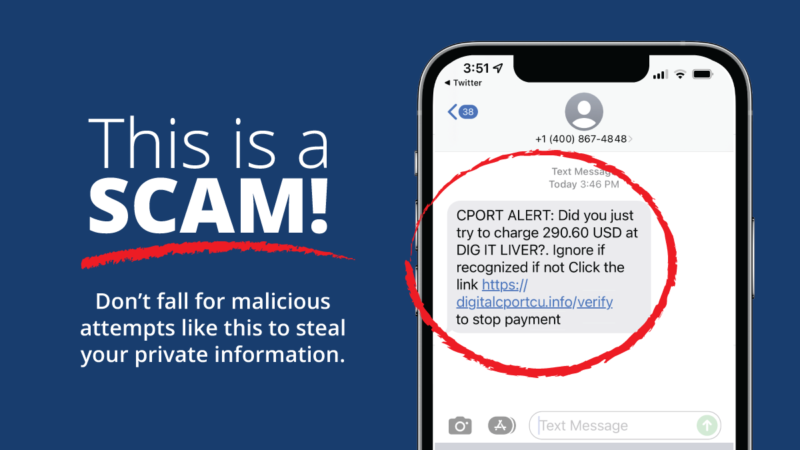Don’t Get Tricked By These Common Scams

Scammers never seem to be short on creative ways to trick you into giving them your private information, often without you realizing it until it’s too late. These usually come in the form of legitimate malicious links but are a sneaky attempt to get you to unknowingly give them sensitive information such as your passwords, bank logins, or social security number.
Keep yourself safe. Remember these rules:
- Never give out personal information unless you initiate the contact.
- cPort will never call or text you and ask for your PIN, or Password.
- Do not open attachments or click on links if you did not request information
- Never share a security verification code or eBanking password.
- Monitor the activity on your accounts regularly.
- Keep information on your accounts current for proper identification purposes.
If anyone calls, emails, or texts you asking for your sensitive information as listed above, do not engage with them. Call cPort at 1-800-464-0253 right away. If our offices are closed, option #2 on our main menu will connect you to 24/7 card support.
Here at cPort, we value our member’s safety and don’t want you to fall for one of these scams. Below is information about current financial scams and tips on how to avoid them
Phishing
Phishing is a scam where you receive fraudulent e-mails or texts that seem to be from a known organization or company (Amazon, Wal-Mart, etc.). They usually ask you to verify personal information such as your Social Security Number, credit card information, or passwords. After this, scammers will take that information and attempt to access your accounts, charge your credit cards, or even apply for new loans.
TIP: You should always contact a company based on information from their official website, do not go off information received via unsolicited links in e-mails or text messages.
Pharming
Pharming is a cyberattack that typically comes in the form of a virus or malicious software that is installed on your computer. When you use the internet, the software will redirect to a fraudulent website without you realizing it. The scammer will try to capture any sensitive information you enter on that website.
TIP: Do not open attachments or click on links if you did not request information or do not recognize the sender.
Below is a list of scams that have taken place over the past few months. By being aware of them, you will be better prepared not to fall for them:
Amazon Scam
In this scam, victims receive a text message that appears to be from Amazon stating that there is unusual activity on their Amazon account and that their account has been suspended. The scammers will then provide a link to unlock the Amazon account. They often will put a sense of urgency on this and say there are only two days to complete this task.
The link will then take unknowing victims to a website that looks almost identical to the Amazon website. The spoof site requires victims to enter a username and password, which the scammers will use to access legitimate accounts.
If you are ever unsure of the status of your Amazon account, please log into Amazon’s official website or app to review your account status. Amazon does not send out account suspension texts or messages. If you receive a text that appears to be from Amazon stating that there is unusual activity on your Amazon account and that your account has been suspended, do not click on the link.
PayPal Invoice
This is a unique scam. Scammers leverage PayPal’s real invoice system to trick victims into giving their personal information out. PayPal has a feature that allows people to send invoices from within PayPal to anybody. Scammers use this feature to send PayPal-verified emails to potential victims
While the email that victims receive is legitimately coming from PayPal, the phone number in this invoice is not PayPal, but a number that connects to a scammer. They answer the phone saying, “PayPal support, how can I help you?” and when the victim attempts to explain that they never made a purchase or order, the scammer will then instruct them to “secure your account” and then sends the victim to a non-PayPal website to enter their personal information.
If you are ever unsure if a PayPal invoice is legitimate, please go to their official website and contact PayPal with the number listed on their website.
Payment reversal scams
Scammers can “spoof” phone numbers, that make it seem like a trusted financial institution is calling or texting victims. In these calls and texts, scammers warn victims there may be fraud on their accounts. They typically say to “reverse” the fraudulent transaction, the victim needs to send money back. These are typically done via Pay-A-Friend and other Person-to-Person methods used in online banking.
cPort will NEVER ask you to send money to fix a transaction. With the recent update of our Pay-A-Friend system, we have enhanced security features that were implemented to mitigate this type of fraud from happening. As always, you should only send money to people you know.
If you are ever unsure if you are truly speaking to a cPort employee, please hang up and call us directly at 800-464-0253
Student Loan Scams
With the recent announcement by the Biden Administration of student loan forgiveness, student loan scams are rising. Scammers usually contact their victims by phone or e-mail. Reported phone scam voice messages usually state the following:
“This is (Insert name) from the processing center. I was giving you a quick call because I’m reviewing your student loan profile, and it looks like there have been some pretty big changes to the federal student loan programs recently. When you have a moment, please give me a callback, I would like to discuss your possible options with you while the programs are still available. It’s urgent you return my call to complete your application before payments resume.”
The ONLY way to be eligible for student loan forgiveness is through the U.S. Department of Education. Anything else is an attempt to retrieve personal information from you.
As of 10/5/2022 the Federal Student Loan Forgiveness application is not live and is expected to be available sometime in early October 2022.
For more information, please visit https://studentaid.gov to learn more.
